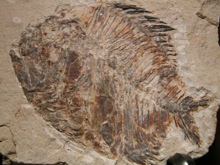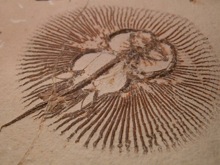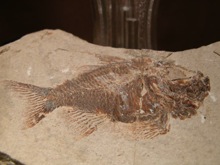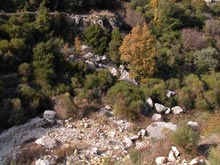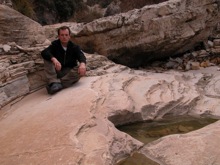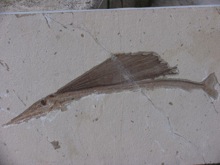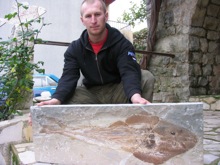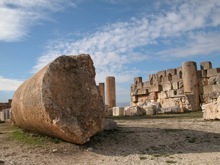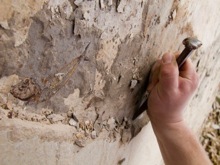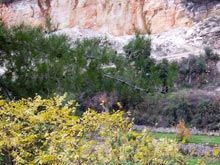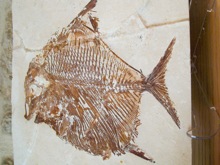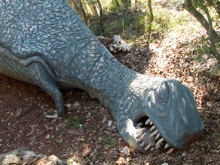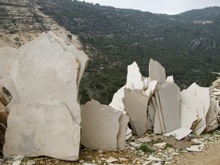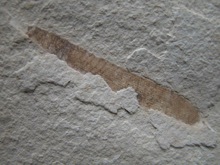Lebanon 2008
7 January 2008, 1.00 am
The German Lufthansa plane is about to land. You can see the neat rows of blue and red runway lights and the glimmering city lights scattered over the surrounding hills. The bearded man sitting next to us says welcome to Beirut. We are shaking hands firmly. A women’s quiet singing comes from the back seats. The plane is landing. We are in Lebanon. It is time to begin the adventure...
Ali - a Polish guy of Palestinian origin travels together with Jarek and me. His family has booked a flat for us in the city centre. Taking into account the price we paid for it, I expected a higher standard than a bath which I was afraid to step into. But there are comfortable beds and hot water, so there is no reason to complain. After 22 hours of travel from Ostrowiec we eventually go to sleep.
7 January, 8.00 am
The view from the 9th floor is as expected. Blue sky, blue sea and white hotel buildings. After opening the balcony door a distinctive sound comes from below...
Every car driver doesn’t hesitate to use the horn at least several times a day. This morning we take a car ride around the city. What we see on the streets of Beirut is reminiscent of a battle without any rules. No traffic regulations apply, road signs and traffic lights are unimportant. Driving the wrong way or driving backwards at great speed occurs on a daily basis. Using emergency lights or fog lights without any reason also seems to be fashionable here.
The city itself is very depressing. A lot of destroyed buildings with shell holes everywhere make a gloomy impression. The rebuilt settlements are guarded by troops and police, nice buildings are surrounded by barbed wire and high fences. Some uniformed men are looking at us in a strange way when we’re taking out our cameras. They’re approaching us but then just say nothing... it’s strange.
We decide that attack is the best form of defence and asking the soldier staying nearby for the permission to take photos. You are allowed to photograph only the legal stuff – he replies.
7 January
Evening in the Bay Rock Cafe. There is a parsnip-tomato salad with lemon juice, grilled aubergine spread, marinated and stuffed vine leaves, fish in sauce. We’re smoking water pipe, puffing away at the aromatic apple tobacco. Arabic coffee, fruit milkshake with pineapple, apple, mango, grapes, cashew nuts, pistachio, strawberry and banana – all that tastes heavenly. We relish the taste with every spoonful. I then come to the conclusion that the Arabic cuisine I got to know in Morocco falls way behind. And we didn’t even try the sweets, for which Lebanon is famous.
The evening goes by slowly. The next – this time grape – argila is finishing off. I would like to be in bed already but the head waiter comes to say that the live band and dancers will appear at midnight. I am weakened and my eyelids are heavy but, well, we decided to wait. It’s time for argila with mint-apple tobacco –Ali says – this taste will bring you round. Jarek and I are joking that it tastes as if we ordered frument.
Reflection: Ali says that despite the tiredness we should stay in the cafe and wait for the performance. In the blink of an eye you will find yourself on the return trip to Poland. He is right. I know how it is from former expeditions. Everything flows. Time slips through our fingers. So we wait and don’t regret it one bit. It’s raining outside.
8 January
Another exciting day. A ride through Beirut during rush hour is entertaining only for people with strong nerves. A European can feel disoriented seeing that nobody slows down or stops on the red light. There are four rows of cars on the three one-way lines. Nevertheless, they are being overtaken by the busses driving on the hard shoulder. If I ever have to come here by my own car I would fit it with additional bumpers. We manage to buy tourist maps in Byblos. They are not especially accurate, taking into consideration that we want to get to Hackel – a small mountainous village.
We are fuelling up the car, agree on a course and after 30 minutes we’re reaching our destination. Just after entering the village we notice boards indicating where the display and selling of fossils are.
In the first house we see nicely lit glass shelves with specimens on the stands. To our big surprise we learn that the best specimens are not for sale! Fossilised branches of a plant resembling araucaria, enormous crabs and lobsters, excellent preserved ray specimens make up the owners’ private collection. We take some photos and buy a few small fishes of Clupea family (herrings). The next place marked by a hanging piece of metal in the shape of a fish looks like a small museum. Inside a frightfully cold building made of white stone there are the glass cases brimming with specimens. There are also gigantic plates with fishes placed along one wall.
Excellent preserved sharks in limestone reach a length of nearly 1.5 m and are beyond our financial range, but the longer we talk with the owners the more the price goes down. We promise ourselves that after finding out more about possible transport options of rocks weighing several dozen kilograms, we would come back here for specimens of museum quality. We choose the fossils, write out the certificates, drink coffee, pack the stuff and it gets dark. We promise the owners we will come back the next day.
Return to Beirut. Fruit milkshake. Water pipe.
At 3pm today there was a bomb attack on UN forces. Two Spanish soldiers were injured in the incident. Reportedly 20 thousand soldiers are patrolling the city. It is hard to verify that number but the uniformed men are almost everywhere.
9 January, 9.00 am
Once again we go to Hackel. I’m driving up in front of the family Noukra’s house (who we got to know the previous day). There already is their son in his vintage Peugeot waiting for us. We change from our car and drive towards the mountains through a dirt road. After a few minutes drive we get out and carry on walking on the path along the spring. After several hundred metres we come across first disclosed white limestone rocks. In the rock debris the brown fish skeletons contrast sharply with the white stones. Jarek is lucky to find a nice ca. 100-year-old „herring”.
After return we are surprised by the hosts – we have the opportunity to see so far undescribed fossilised fish. We have to think twice whether it is safe to take a thin stone plate which is priced 200,000 dollars in our hands. We have an impromptu photo session – Jarek poses for photos with sharks.
At the end of the day we visit Hackel Museum where we see some sensational fossils. It’s a pity that the exhibition isn’t very professional. The specimens lean one against another and there are just too many to focus on them properly.
10 January
We go to the harbour in the morning in order to arrange the transport of fossils to Poland. These goods must be atypical because the forwarding company doesn’t know how to deal with that matter. Based on the information from Poland we find out that the customs have doubts about what duty rate are on our stuff. It may be the case that we are forerunners on this subject.
We go to the Namura village and apart from fish we manage to find fossilised plants. Unfortunately, work in the quarry is suspended for the winter period. The limestone won’t be extracted and crushed into big plates before late spring. This kind of stone behaves completely differently and it’s hard to extract it when it’s wet. We promise ourselves that next time we come here in July.
If it weren’t for the fact that driving on the roads of the Lebanon is so crazy, it would be pretty nice here. After two hours drive as a passenger you feel mentally and physically exhausted. We barely escaped a collision today by a matter or mere centimetres.
11 January
We spotted a nice photo of a cage in a travel guide. After a quick decision we head towards it. But first we visit a cake shop in Beirut. There are piles of cakes and doughnuts and the shop windows are full of colourful cakes. The waiting staff are so pleased with me running around and taking photos that they quickly prepare a table and chairs. We are pleasantly surprised that the sweets are as tasty as they look. I put one into my pocket...
After the breakfast we set off for the Jeita cave. Although the roads are badly signposted in Lebanon, a surprisingly well-marked trail leads us right to the cave.
We buy tickets and the guide directs us to the gondola lift. After a short ride over a river valley we appear at the entrance to the upper cave system. Unfortunately, they take our cameras and phones as a deposit. Then we start walking through a wet and humid concrete corridor and... wow!
A gigantic cave meets our eyes. The path leads through the huge underground chambers and corridors. An amazing play of colourful lights over thousands of various dripstone forms would undoubtedly make this place a tourist mecca anywhere in the world. But due to the fact that there is not enough oxygen in the deeper parts of the cave, the route is available for only several hundred metres, which is enough for us, anyway. Whispering to each other as if we were in the church we keep walking.
Apart from the upper cave, the flooded lower system is also accessible to visitors. As soon as we approach the entrance, we can hear the swoosh of water. We board a small raft and start floating through the underground river.
Later this day we visit Aleg’s brother-in-law living in a small town Saida not far from the Palestinian refugee camp. There are military checkpoints every several dozen metres, bunkers on every crossroad, sandbags, tangled barbed wire and streets sheltered by concrete slabs – in a word – architectural chaos. Finally we take a photo of a wreck of an armoured vehicle...
12 January
We rent a taxi in Beirut and go to neighbouring Syria for the weekend. Our destination is Damascus. It’s time for a handful of anecdotes from the trip.
We have to get Syrian visas at the border. There is a notice stating that 1 visa costs 28$. I take out a 100$ note and ask for 3 visas. Then I get 15$ change and 3020 Syrian pounds. I give this money to the border guard from the window nearby and he pastes the visas into our passports. Will you solve this riddle: HOW MUCH DOES 1 SYRIAN VISA COST?
We pass the border and enter Syria. The taxi stops at the petrol station. We wonder why we fuel the car here. “It’s because fuel is very cheap here. So how much is one litre?” – we ask. “5000 Lebanese lira for 20 litres”. Try to puzzle out yourself...
Two days ago we got a falafel with bread and vivid pink pieces of an unknown vegetable. „What’s this?” – we ask. „White turnip” – they reply.
Conclusion: there are some things which Arabs just can’t explain. It’s just waste of your and their time and you’ll end up confused anyway.
14 January
We go to the harbour and visit the company which is expected to deliver our stones to Poland. Our guide says „it’s nice and warm today, not too warm”. Have I mentioned before that you can be confused?
It’s very difficult to come to an agreement on delivery conditions, packing form and even a price with a company that delivers goods for all over the world. Despite the fact that we have to wrap the specimens ourselves in bubble pack we still have to pay for packaging. Additionally, there is a strange charge for „export paper”. Previously they promised us a wooden box; today we got two pallets instead. A few days ago we learnt that the parcel would be delivered to Poland within 2-3 days. Two weeks passed since that time and the stones are still at the Beirut airport.
It’s time for another 2 anecdotes:
We are in the bar and ask Ali for 2 sandwiches: one with vegetables wrapped in Arabic bread, another one with three sauces and shashlik. Instead, we get French fries and chicken wrapped in bread.
Then we buy water pipes to take home. I choose a brown one, Jarek wants the same. Have you got more brown ones like this? – we ask. Yes, from this kind I’ve got blue – the shop-assistant replies.
15 January
I advise you against travelling around Lebanon after what we experienced today. And it started so innocently.
We decided to see cedar trees in their natural environment. The cedar features on the Lebanese flag after all, but in order to achieve our goal we had to reach the higher parts of the mountains. In spite of appearances there aren’t many cedar habitats. We decide to see them near the village Tannourine. I don’t know how high we managed to drive as it’s impossible to buy a good topographical map for, presumably, security (military or strategic) reasons. We reached the snow level and we were climbing up until the road leaded along the sunny slope. Everything was going well until the time when the road was in the slope’s shade. Immediately ice appeared on the road. The wheels began to slide. We stopped and sprang out of the car while Ali moved the car backwards to the asphalt. We started again pushing the car through the first section of ice. What a mistake we had made! Then it got worse and worse. The car was sliding with its wheels churning. We gave up and decided to drive down backwards to a place where we could turn back. But then another problem appeared: on the slope the car’s brakes proved useless. Rolling the car down, while at the same time supporting it to prevent it slipping down, took a good half an hour. But as we could see two huge cedar silhouettes on the horizon, we didn’t back down. We decided to reach Les Cedres from the north-west and set off to Tripolis. We got slightly lost in the city but after some time we found the way and carried on to the mountains. Suddenly a small lorry cut in on us. A squeal of tyres and the smell of burning rubber, the car heading forwards in spite of frantically turning the steering wheel… shaking calves after and a feeling that we managed it once again.
Despite the coming sunset we were driving upwards. And we made it. Snow on the slops was glowing pink, the cedars covered with white powdery snow were there. We managed to take a few photos before it got completely dark. And then we got a message from Beirut. There was a bomb attack which killed 3 people and left over 20 injured. Just the day before we were there for dinner.
16 January
The road to Baalbeck. On the both sides the images of Hezbollah fighters, green and black funeral flags. The new 1429 Muslim New Year began on the 10th of January. From that day on Shia Muslims prepare for another nine month celebration of Azsura in memory of the death of Mahomet’s grandson Hussein. For they these are days of pray, penance and fasting. Special ceremonies are celebrated in their mosques.
We came across such a celebration where I managed to take three photos of a building where Muslims were gathering. Shortly after that three bearded and broad-shouldered men carrying short-wave radios in their hands asked me aside. They checked most of the photos I’d taken during the trip to make sure that I took only photos of buildings and not of people. They asked me where I was from, what I did, where else I had travelled etc. I was afraid of my camera and photos a little. But in the end they just told me to ask for their permission to take photos next time. I wonder what they were hiding under their armpits…
I thanked them, took back my camera and left swiftly.
Later we visited the ruins of an ancient Roman town. A beautiful place which doesn’t fit in with the contemporary Lebanese atmosphere at all. This is a monumental Helipolis –City of the Sun.
Next days
After the adventures of recent day we’d had enough of car trips outside Beirut. Besides, we had problems with sending the stones to Poland and we lost our sense of humour. We spent our last days basking in the sun, walking along the beach, observing anglers and other strollers (I mean mostly females). The stones which went and will go through will make an integral part of the exhibition in the Karol Sabath Museum of the Earth in Solec Kujawski.
Translation from the Polish: Paweł Jankowski Proofreading: Will Harper




